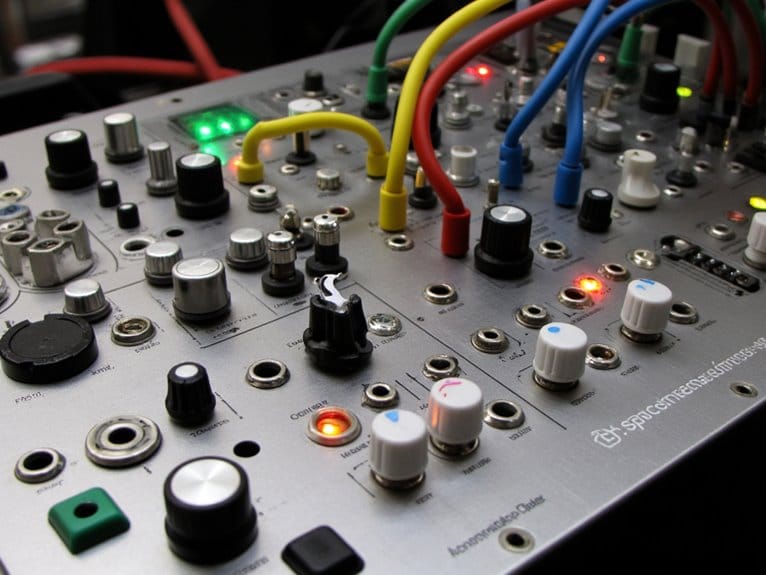Panning Tips for Better Mixing
Center your kick, snare, bass, and lead vocals to maintain mono compatibility and low-frequency coherence, while panning supporting elements like guitars and keyboards to opposite sides for width. You’ll want to avoid hard-panning essential elements or clustering multiple instruments at identical positions, as this creates frequency masking and weakens your mix foundation. Use subtle 5-10% displacement for bass elements and automate panning movements to create dynamic interest without compromising your stereo field’s structural integrity-there’s much more to explore.
We are supported by our audience. When you purchase through links on our site, we may earn an affiliate commission, at no extra cost for you. Learn more.
Notable Insights
- Keep lead vocals, bass, kick drum, and snare centered to maintain mix foundation and mono compatibility.
- Use subtle opposite panning for bass and kick (5 ticks) to enhance low-end clarity without losing punch.
- Employ complementary panning by placing similar instruments at opposing positions to reduce frequency masking and clutter.
- Avoid hard panning essential elements and grouping multiple tracks at identical pan positions to prevent mix weakness.
- Automate instrument positions dynamically across song sections to create emotional impact and enhance rhythmic layering.
Essential Panning Strategies for Core Mix Elements
When you’re building a solid mix foundation, I’ve found that understanding which elements belong in the center position is absolutely essential for creating professional-sounding results.
Understanding which mix elements belong in the center position is absolutely essential for achieving professional-sounding results.
Your lead vocals, bass, kick drum, and snare should anchor the middle of your stereo field, providing the structural backbone that holds everything together.
I’ll admit, it took me years to appreciate why center positioning matters so much for low-frequency elements, but the phase coherence benefits are undeniable when you’re checking mono compatibility.
These core elements maintain their impact across different playback systems because they avoid the frequency clarity issues that occur when bass frequencies get panned hard left or right, which can create problematic phase relationships and weaken your mix’s foundation. Understanding pan law helps you maintain consistent perceived loudness as you position these elements throughout your stereo field.
Placing elements outside these traditional locations naturally draws the listener’s attention and can create unique sonic experiences when used intentionally.
Creative Techniques for Dynamic Stereo Movement
While static panning creates a solid foundation, I’ve discovered that introducing controlled movement across the stereo field transforms good mixes into enthralling sonic experiences that evolve throughout a song.
Dynamic panning achieves this by cycling sounds between channels, particularly effective on percussive elements and synths where tempo-synchronized movement enhances rhythmic layering.
I’ll automate instruments to shift positions between sections-perhaps panning a guitar left during verses, then centering it for choruses to create emotional impact.
You can also employ complementary panning on overlapping frequencies, placing similar instruments at opposing positions like 20% left and right to reduce masking. Understanding the Haas effect helps optimize these placements, as delays up to 35ms can create spatial enhancement before listeners perceive actual separation.
Multi-band auto panners enable sophisticated techniques by breaking signals into frequency bands, allowing different ranges to move independently across the stereo image. Quality audio interfaces with zero-latency monitoring make it easier to implement these real-time panning techniques without distracting delays during the mixing process. Professional interfaces with XMAX preamps provide the clean amplification needed to capture these spatial movements with exceptional clarity and minimal noise.
Even subtle bass and kick displacement, just 5 ticks opposite each other, improves low-end clarity while maintaining punch and mono compatibility.
Common Panning Mistakes to Avoid in Your Mixes
Although dynamic panning techniques can elevate your mixes to professional levels, I’ve noticed that even experienced engineers fall into predictable traps that undermine their stereo imaging and overall mix quality.
These panning errors create stereo imbalance that damages your sonic landscape, making tracks sound amateur despite excellent individual performances.
Here are the most damaging mistakes I’ve encountered:
- Hard panning essential elements like kick drums, bass, or lead vocals, which destroys mono compatibility and weakens your mix’s foundation.
- Bunching multiple tracks at identical pan positions, creating frequency masking and cluttered soundstages that lack proper separation.
- Confusing panning with volume balancing, leading to unnatural stereo placement and inconsistent spatial imaging across your mix.
- Using phase tricks to create fake stereo width, resulting in hollow sounds and destructive interference.
- Ignoring arrangement context when making panning decisions. Remember that overly wide panning can result in weakness when your mix is played back on mono systems, compromising how your music translates across different playback environments.
Your monitor setup significantly impacts panning decisions, as improper speaker placement leads to unclear perception of stereo separation and poor spatial choices.
On a final note
You’ve got the fundamental panning strategies down, and I’ve walked you through creative movement techniques that’ll add dimension to your stereo field. Remember, you don’t need to overcomplicate things-start with basic left-right placement for your core elements, then experiment with automation and mid-side processing once you’re comfortable. Most importantly, trust your ears over rules, because every mix presents unique challenges that require flexible thinking and practical solutions.







